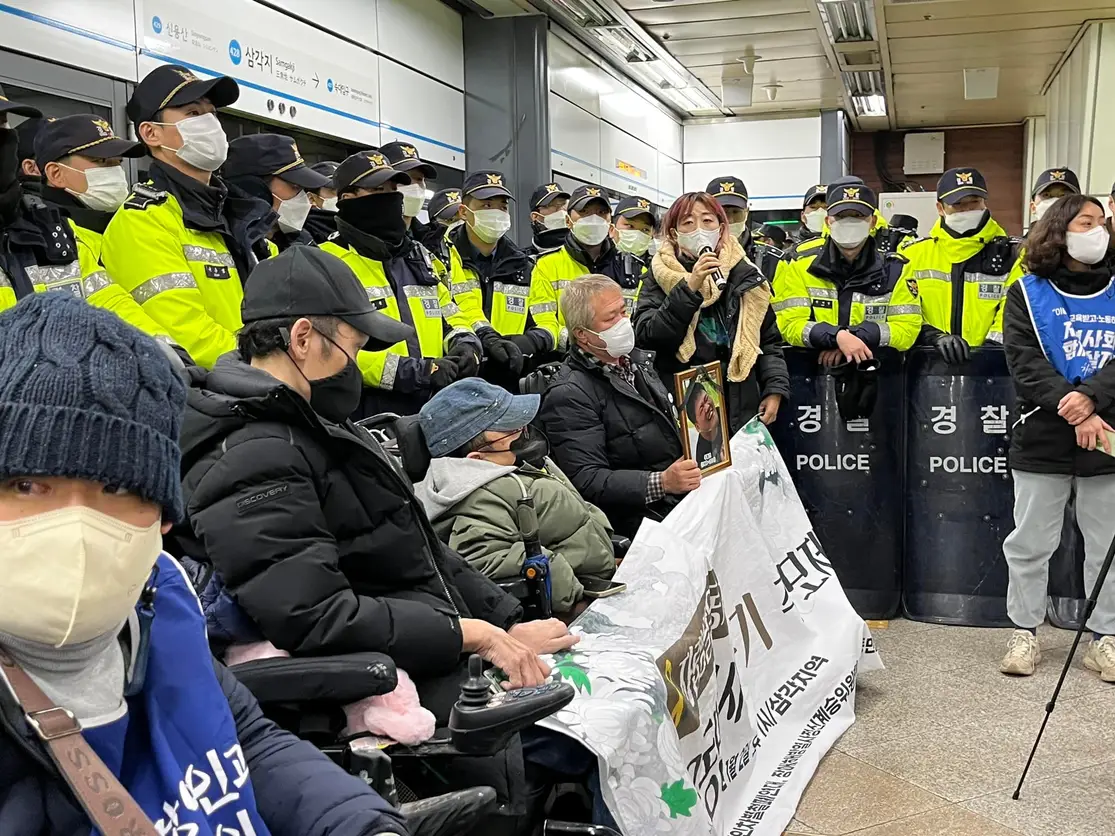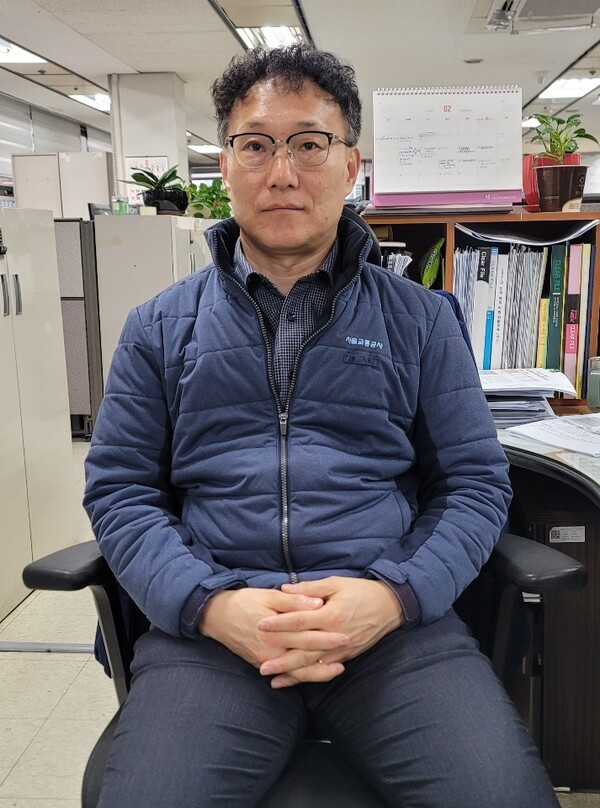When referring to transit systems funded by the government such as subways and buses, “public transport” is the term most commonly used. However, the Korean word for such transportation conveys the meaning of mass transit. Although the difference may seem insignificant, it reflects a key aspect of Korea’s public transportation system: a focus on the function of efficiently moving large numbers of people rather than the needs for the public. When something is described as “public,” it implies accessibility to all ordinary citizens who are not part of the government or holding significant positions. The Korean interpretation of the term “ordinary” appears to be quite literal, as some of the social minority face challenges in using public transportation.
In January 2001, a disabled couple boarded the wheelchair platform lift at Oido subway station to visit their son for the New Year Holidays. The metal wire supporting the lift broke causing the couple to fall 7m below, resulting in their deaths. This incident was not isolated; two years earlier, in 1999, separate accidents related to malfunctioning wheelchair platform lifts occurred in the Hyehwa and Cheonho stations. Similar accidents happened four times in 2001 and subsequently until as lately as 2017. Five people have lost their lives in such accidents and more have been severely injured. These accidents underscore the critical importance of mobility: a basic right essential not only for convenience but also for survival.

In response to such incidents, various social movements have emerged. Among them, the Solidarity Against Disability Discrimination (SADD), established in 2007, has been a prominent advocate for the rights of disabled people. Recently, however, SADD has faced criticism for its recent and ongoing public demonstrations, which have caused delays in major public transport services. During these demonstrations, activists using wheelchairs board subway trains, causing delays and congestion on platforms and inside stations during peak commuting hours. The chaos has led to confrontations with law enforcement, leading to numerous arrests.
In 2023, Park Kyung-suk, the head of SADD, was arrested and prosecuted for obstruction of work during a protest. As the demonstrations often cause inconvenience and physical conflict while evicting the protestors, they are often referred to as “illegal” by numerous media outlets and politicians. According t o K i m P h i l-soon, director of SADD’s planning department, there have been many arrests during these protests, but only one case has been prosecuted. The protester was prosecuted for damage to public property for attaching hundreds of stickers on the floors of the station platform. The 127.8 million won lawsuit by t h e S e o u l M e t r o w i l l t a k e p l a c e this April.

Seoul Metro has been taking measures to promote mobility rights for the transportation vulnerable. For e x a m p l e , t h e S e o u l M e t r o launched a mobile service providing information to facilitate transport in 2022. This information includes the location of dysfunctional elevators, electric wheelchair chargers, and lactation rooms. The service also provides sign language translation and vocal navigating service inside the station via existing beacons. According to Kwak Seung-bum, the head of Seoul Metro customer service, Seoul Metro has also been trying to install automatic safety steps in the platforms. Steps rise to fill the gap between platforms and trains when the train stops. The steps not only help to board wheelchairs, strollers, and walkers but also prevent falling between the gaps which happens about 60 times yearly. They have finished five installations in 2023 and are planning for more. However, Kwak adds that there have been challenges in passing safety regulations and securing enough budget for the project.

Due to the publicized intrinsic danger of wheelchair lifts, Seoul Metro has allocated 77.1 billion won to install elevators in subway stations. The effort has led to 94 percent of stations having complete elevator connections, a significant increase from 8.5 percent in 2013. Kim Hyun-sik, a 49-year-old paraplegic who travels through the subway in an electric wheelchair every week, stated, “The installation of elevators has enabled me to use the subway. The lifts are not only dangerous but very inconvenient because if I am traveling alone, I have to call and wait for the social service personnel to arrive, which is a hassle when transferring. Five years ago, when I could still walk with a walker, I used the stairs to avoid the inconvenience.”
The Act on Promotion of TheTransportation Convenience of Mobility Disadvantaged Persons was established in 2005. One of the major contents of the law was the renewal of facilities such as elevators and kneeling buses. It also depicts Special Transport Service (STS), more widely known as the “Call taxi” for the disabled. The most recent renewal in December 2022 includes a complete transition from regular buses to kneeling buses and enabling travel between cities via the STS.
Kneeling buses are buses without stairs at the entrance, allowing easier boarding for regular passengers while also enabling boarding for wheelchairs and strollers. For the complete transition, all newly released buses are to be kneeling buses. The current goal is to increase the fulfillment rate from 30.6 percent in 2021 to 62 percent by 2026. Although the significant number of 30.6 is admirable, a closer look is needed.
Firstly, the number itself does not reflect the gap between Seoul and non-Seoul areas. Whereas the penetration rate of kneeling buses in 2021 was 59.7 percent inside Seoul, the rate for Gyeonggi-do was 19.2 percent. The situation in non-Seoul areas is even worse. O n l y 9 . 9 p e r c e n t o f b u s e s i n Chungcheongnam-do are kneeling buses, 12.1 percent for Ulsan-si, and 16.8 percent for Cheollanam-do. Secondly, it is hard to use such kneeling buses. Although the law mandates that kneeling buses and regular buses should be dispatched in an accordingly manner, it is not always strictly applied, especially in non-Seoul areas. The allocation of kneeling buses is done circumstantially without a fixed schedule, making it hard for the users to utilize them.
STS is an affordable state-funded cab service equipped to provide transport for disabled people. Although this unique Korean service has provided convenience for many, it still has problems. Firstly, the service’s impracticality is evident in the average waiting time for cab allocation, which is 41 minutes. The law mandates one cab per 100 disabled people. As the service is enacted on a city basis, traveling between cities via cab is impossible, requiring users to transfer to a different cab. Since there is no official transfer service, users must wait another 41 minutes. Secondly, not all disabled people can use the service. Seoul STS restricts the users to people with significant disabilities affecting their ability to walk. In 2022, a lawsuit was filed regarding the issue. The person who brought the charges forward suffered from cerebral palsy and could not walk without a walker, yet he was denied the service because the disability was not severe enough in the legs. The court ruled in favor of the claim, according to the legislative intent. Currently, the service is restricted to people with degree one or two disability. However, considering that the couple from the Oido incident had a degree three disability, the inclusiveness of the service remains questionable.
“We understand the inconveniences that we may cause through our protests, and we feel sorry. However, we have been denied boarding to the subway every time during the whole of 2023 apart from one exception. Listening to the voices of the voiceless is a virtue of a civic society. As a democratic citizen, please listen to our voices, and let us make a better society together,” SADD comments as they concluded the interview. Ten minutes after the interview, they briskly leave for a press conference to continue their part as democratic citizens.

